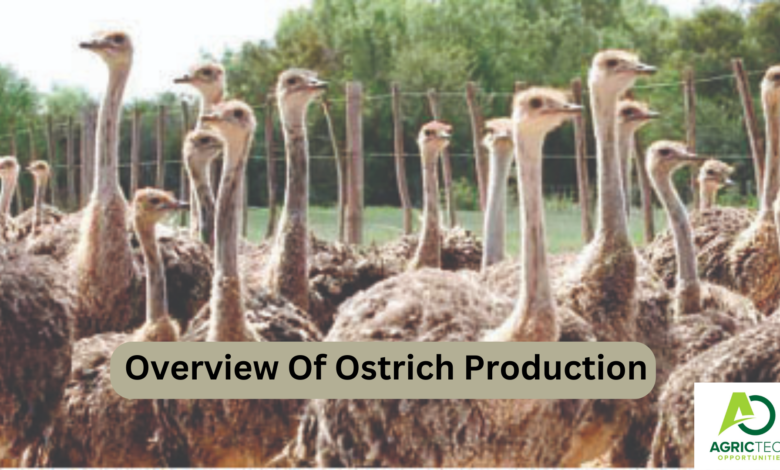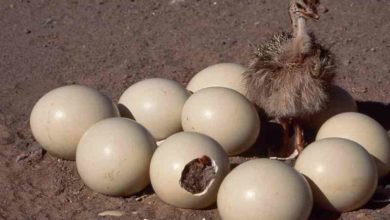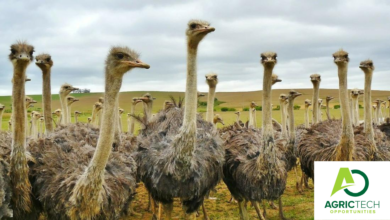The Approved Overview Of Ostrich Production 2023 |Ostrich Farming Guide|

Host Country
GLOBAL
Target Audience
INTERNATIONAL OSTRICH FARMERS
Program Overview
The ostrich (Struthio camelus) is a large flightless bird native to southern Africa. It is the only living member of the genus Struthio. Other running birds often ranched include:–Kiwi (New Zealand), Emu (Australia), Rhea (South America) and Cassowary (New Guinea & Australia). Ostrich is largest living bird and lays the largest eggs of any species.
The ostrich’s diet consists of mainly plant matter + some invertebrates. When threatened, the ostrich will either hide itself by lying flat against the ground, or run away. If cornered, it can attack with a kick of its powerful legs (powerful enough to split a man from top to bottom).
ALSO READ: How To Easily Perform Artificial Insemination Technique (AI) In Various Species Of Farm Animals
Overview Of Ostriches
•They differ from other birds: Has only two toes (instead of three); flightless
•Territorial males fight for a harem of two to seven females
•Adult Ostrich weighs 63 – 145 kg
•Height at sexual maturity (2-4 years) can be up to 2.8 for males and 2.0m for females
•Their lifespan is up to 40–45 years
Young chicks
–fawn in colour, with dark brown spots, grow very fast
–weigh approximately 45 kg at 1 year
Adult males
–mostly black, with white primaries and a white tail
Adult females and young males
–are greyish-brown in colour
•The head and neck of both male and female ostriches is nearly bare, with a thin layer of down
•The skin of the female’s neck and thighs is pinkish grey, while the male’s is mostly blue-grey
•Neck and thigh muscles are well developed and un-feathered (bare)
•Lives in nomadic groups of 5-50 birds
ALSO READ: The Ultimate Guide To Rabbit Production- WHY KEEP RABBITS

Male and female ostriches
Adaptation to predation
•Major predators – cheetahs, lions, leopards, hunting dogs, spotted hyenas
•Mechanisms
–Height – 2-3m
–Acute eyesight and hearing
–High running speed – > 70 km/h and can maintain a steady speed of 50 km/h; strides of 6-8m long
–Hiding from predators
–Fighting – forward kick of up to 225kg
Habitat
•Open habitats and poorly vegetated
–Semi-arid, open and short-grass plains are usually associated with the highest ostrich densities
•The challenge of the ostrich is that it is
–xeric, flightless and very large
–it cannot fly to far away water sources
Adaptation to aridity
Mechanisms
•Large surface area to volume ratio – less evaporative water loss
•High water intake
•Specialised excretory organs (coprodeum and cloaca) for net water conservation
•Metabolic water production mechanism as a source of hydration
•Food – consume succulent plant parts
Adaptation to heat stress
•Feather fluffing – increases convective heat loss at high ambient temperatures
•Panting – no sweat glands; evaporative heat (and water) loss from its respiratory surfaces
•In cold temperatures the ostrich utilizes feather flattening; covering its bare legs using the wings; pilo-erection and shivering
ALSO READ: Top Principles Of Pig Nutrition For 2023/24
Uses of the Ostrich wings
•Uses of the wings
–Temperature control
–display purposes – courting, submission, aggression
–protecting eggs and young ostriches
•Confidence and aggression
–bird will hold its head and neck high, with the front of the body tilted upwards and the tail up
•Submissiveness
–bird will hold its head low and its tail down
ALSO READ: Approved Principles Of Poultry Production For 2023/24
Behaviour and Adaptation
•Diurnal birds
–travelling in search of food and water
–dust-bathing, resting or nesting
•During the night
–they completely rest
•Like camels, ostriches can travel for long distances in search of food and water
The chicks and juveniles
–are strictly gregarious and always remain in compact groups
Adults
–are semi gregarious and tend to be attracted to each other for short periods of time
ALSO READ: The Benefits of Doing an Internship: How It Can Help You Get Ahead in Your Career
For more updates On Agric Tech Opportunities kindly join the social groups below:
Join our Telegram | Follow us on Linkedin | Also, Follow us on Twitter. | Join Our Whatsapp Group
God bless and All the best !!


